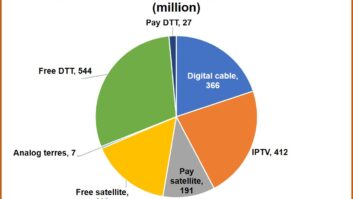
By Heather McLean
Mobile TV, which seemed to have died a death over the last few years, has come back fighting. After the service seemed to have all but disappeared in the mobile industry, at last month’s Mobile World Congress in Barcelona mobile TV saw a resurgence — not as a separate service but as one part of the mobile content ecosystem that is finding favour among smartphone and tablet users.
A case in point comes from Juniper Research, which stated at the show that growing user satisfaction with mobile TV on tablets will push average monthly viewing times to 186 minutes per month in 2014. Juniper said as users become more accustomed to viewing content on tablets, and as a wider range of content becomes available, consumers will increase their viewing times. It added that a tablet is the ideal device on which to consume mobile TV content, with a large screen size and intuitive user interface that allow almost everyone to browse for and watch content.
This increase in viewing will be most apparent in North America where there is already significant mobile TV usage, and where internet TV services such as Hulu and Netflix are extremely popular, Juniper claimed in its ‘Mobile TV: Applications, Devices and Opportunities 2012-2016’ report. The report also found that the number of users of streamed mobile TV services on smartphones will increase by 2.8 times between 2011 and 2016.
Another driver for this growth, the report claimed, is the continued integration of mobile services into pay-TV packages. Tablets can offer a richer viewing experience when used alongside traditional television by allowing the user to access supplementary information, such as plot synopses and actor biographies. These devices also enable users to view pay-TV content or to watch catch-up services when away from home, extending the reach of traditional TV services.
Ido Wiesenberg, cofounder and VP business development at Tvinci, a pay OTT TV platform, stated: “Three years ago mobile TV was nothing to do with TV providers; it was a separate thing, but we believe you need to connect everything together.
“Companies that were previously working with mobile TV on 3G had in mind very managed solutions that focused on the infrastructure rather than the end user; now the focus is on the end user, who wants to combine all their devices together, so they can get one experience that converges everything together. No one wants to launch a service that is just for the mobile anymore.”
Mark Hyland, GM Europe at QuickPlay Media, provider of managed solutions for the distribution of premium video to IP-connected devices that acquired Qualcomm’s Flo TV assets in San Diego back in June 2011, commented: “It’s about the personalised TV experience, with tablets versus ‘wall’ TV, and smartphones versus the landline.
“It doesn’t matter if you have a wall TV and a fixed line, you are still going to use your cell phone and your tablet for a personalised experience. Tablets are truly media consumption devices and provide a personalised TV experience. In point of fact, 70% of the time people are using their tablets to consume video content, they are in their home. This marks an enormous shift in people’s viewing habits.”
Provider of managed TV everywhere services, MobiTV’s CTO, Kay Johansson, agrees: “Following the user experience is key; you should be able to get home and put a bookmark on your tablet viewing, then pick it up again where you left off on your TV. We think of ourselves as doing mobile TV everywhere, not on the mobile only. It’s got to be able to move from the mobile to the TV to the desktop and to the tablet, as required by the user. This isn’t a test any more, it’s the real deal and a lot of carriers already rely on these services to retain customers.”
MobiTV announced that during the month of September 2011, consumers viewed more than 167 million minutes of mobile television on MobiTV-powered services, the highest total for any month in MobiTV history. Of note, 65% of the minutes viewed were live programming.
Mark Hyland added: “It’s not so much about bringing TV to mobile with distinct content; it’s about bringing mobile to TV, so you can have content available on whatever device you own. Consumers are more likely to want live TV and VoD services, the same as what they see on their TV at home — on their mobiles, not a mobile-specific service.”
Wiesenberg concluded: “Five years from now I believe all TV will be on all major devices; I don’t think someone will pay to have content for just one device.”







